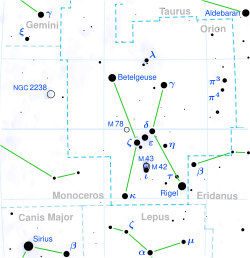觜宿一
| 觀測資料 曆元 J2000.0 | |
|---|---|
| 星座 | 獵戶座[1][2] |
| 星官 | 觜宿 |
| 赤經 | 5h 35m 8.3s[1][2] |
| 赤緯 | +9° 56′ 3″[1][2] |
| 視星等(V) | 3.54[1][2] |
| 特性 | |
| 光谱分类 | O8III((f))[1][2] |
| U−B 色指数 | -1.03[1][2] |
| B−V 色指数 | -0.18[1][2] |
| R−I 色指数 | -0.17[1][2] |
| 天体测定 | |
| 徑向速度 (Rv) | -1.03 km/s |
| 自行 (μ) | 赤经:34 mas/yr 赤纬:- mas/yr |
| 视差 (π) | 0.007 mas |
| 距离 | 465937.68571429 ly (142857.14285714 pc) |
| 其他命名 | |
| 參考資料庫 | |
| SIMBAD | 资料 |
命名
性質
觜宿一的主是一顆巨星,光譜類型為O8III,視星等3.54等。它是一顆巨大的恆星,質量大約是太陽的28倍[3],半徑是太陽的10倍[4]。外圍大氣層的有效溫度大約是35,000K[4],賦予它發出藍色光的O型星特徵[5]。觜宿一是一個軟X射線源,亮度為1032 erg s−1,輻射的峰值範圍在0.2±0.3KeV,顯示X射線可能是由恆星風產生的[6]。
觜宿一是一對聯星,與伴星分離的角距離為4.41角秒,位置角43.12度(在1937年)[7]。伴星比主星黯淡,視星等為5.61等,光譜類型為B0.5V,是一顆B型主序星。外圍還有另一顆伴星,它是一顆F型主序星,光譜類型為F8V。這顆恆星自己可能還有一顆質量非常低的伴侶,可能是一顆棕矮星 [6]。
環

(NASA/JPL-Caltech/UCLA)
環繞著觜宿一的星雲環直徑約12度。它被認為是超新星爆炸的殘骸,現在被來自觜宿一本身和周圍一些高溫恆星的紫外線輻射電離[8]。
星協
觜宿一是500萬年前的一個恆星形成區域的主要成員,該區域被稱為獵戶座λ星協[9],或科林德69。它輻射出的強烈紫外線能量創造了Sh2-264 [10],形成環繞在它周圍空間的氫離子區,或是說它被一個年齡約200萬年至600萬年,已經冷卻的氣體環包圍著。這個膨脹的氣體環被解釋為可能是觜宿一之前的伴侶,成為II型超新星後噴出的殘骸。這樣的事件也可以解釋在膨脹環中心恆星的本動速度,因為爆炸和因此造成的質量速度可能把觜宿一踢出系統。超新星殘骸的候選者是中子星傑敏卡[11]。但是,鑒於傑敏卡和星協之間的距離,最後被認為不太可能.[12]。
參考資料
- ^ van Leeuwen, F., Validation of the new Hipparcos reduction, Astronomy and Astrophysics, November 2007, 474 (2): 653–664, Bibcode:2007A&A...474..653V, S2CID 18759600, arXiv:0708.1752
 , doi:10.1051/0004-6361:20078357
, doi:10.1051/0004-6361:20078357
- ^ Murdin, P.; Penston, M. V., The Lambda Orionis association, Monthly Notices of the Royal Astronomical Society, December 1977, 181 (4): 657–665, Bibcode:1977MNRAS.181..657M, doi:10.1093/mnras/181.4.657

- ^ 1.0 1.1 1.2 1.3 1.4 1.5 1.6 1.7 Pulsating variable Star. SIMBAD. Centre de Données astronomiques de Strasbourg. [2012-07-13]. (原始内容存档于2019-06-11).
- ^ 2.0 2.1 2.2 2.3 2.4 2.5 2.6 2.7 VizieR Detailed Page. [2012-07-13]. (原始内容存档于2016-03-05).
- ^ Tetzlaff, N.; Neuhäuser, R.; Hohle, M. M., A catalogue of young runaway Hipparcos stars within 3 kpc from the Sun, Monthly Notices of the Royal Astronomical Society, January 2011, 410 (1): 190–200, Bibcode:2011MNRAS.410..190T, S2CID 118629873, arXiv:1007.4883
 , doi:10.1111/j.1365-2966.2010.17434.x
, doi:10.1111/j.1365-2966.2010.17434.x
- ^ 4.0 4.1 Underhill, A. B.; et al, Effective temperatures, angular diameters, distances and linear radii for 160 O and B stars, Monthly Notices of the Royal Astronomical Society, November 1979, 189 (3): 601–605, Bibcode:1979MNRAS.189..601U, doi:10.1093/mnras/189.3.601

- ^ The Colour of Stars, Australia Telescope, Outreach and Education (Commonwealth Scientific and Industrial Research Organisation), December 21, 2004 [2012-01-16], (原始内容存档于2012-03-10)
- ^ 6.0 6.1 Franciosini, E.; Sacco, G. G., XMM-Newton observations of the young open cluster around λ Orionis, Astronomy & Astrophysics, June 2011, 530: A150, Bibcode:2011A&A...530A.150F, S2CID 118633609, arXiv:1104.3803
 , doi:10.1051/0004-6361/201015248
, doi:10.1051/0004-6361/201015248
- ^ Scardia, M., Micrometric measurements of binary stars (first list), Astronomy and Astrophysics Supplement Series, September 1983, 53: 433–440, Bibcode:1983A&AS...53..433S (法语)
- ^ Koenig, Xavier; Hillenbrand, Lynne A.; Padgett, Deborah L.; Defelippis, Daniel. SPECTROSCOPIC ASSESSMENT OFWISE-BASED YOUNG STELLAR OBJECT SELECTION NEARλANDσORIONIS. The Astronomical Journal. 2015, 150 (4): 100. Bibcode:2015AJ....150..100K. S2CID 20902398. arXiv:1506.05141
 . doi:10.1088/0004-6256/150/4/100.
. doi:10.1088/0004-6256/150/4/100.
- ^ Bouy, H.; et al, A deep look into the core of young clusters. II. λ-Orionis, Astronomy and Astrophysics, September 2009, 504 (1): 199–209, Bibcode:2009A&A...504..199B, S2CID 1595852, arXiv:0907.0322
 , doi:10.1051/0004-6361/200912569
, doi:10.1051/0004-6361/200912569
- ^ Barrado Y Navascués, D. Hidalgo-Gámez, A. M.; González, J. J.; Espinosa, J. M. Rodríguez; Torres-Peimbert, S. , 编. II International GTC Workshop: Science with GTC 1st-light Instruments and the LMT. Revista Mexicana de Astronomía y Astrofísica (Serie de Conferencias) 24. December 2005: 217–218. Bibcode:2005RMxAC..24..217B.
|contribution=被忽略 (帮助) - ^ Cunha, K.; Smith, V. V., Is the expanding molecular cloud surrounding λ Orionis caused by a Supernova?, Astronomy and Astrophysics, May 1996, 309: 892–894, Bibcode:1996A&A...309..892C
- ^ Pellizza, L. J.; et al, On the local birth place of Geminga, Astronomy and Astrophysics, May 2005, 435 (2): 625–630, Bibcode:2005A&A...435..625P, S2CID 15223974, arXiv:astro-ph/0502190
 , doi:10.1051/0004-6361:20042377
, doi:10.1051/0004-6361:20042377
